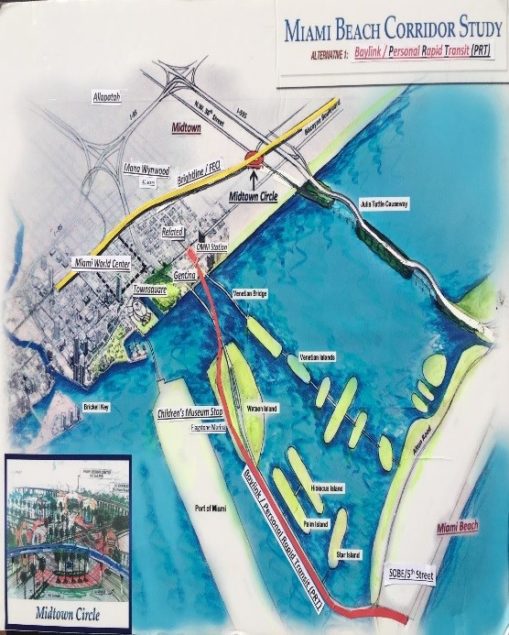
The Baylink connector is important because it connects Miami’s vibrant downtown with our number one tourist attraction—South Beach. Baylink requires some elevated spans because it crosses the bay and was always conceived as an elevated system on rail. As a former Baylink Executive Committee member, I convened sunshine meetings in March to present Personal Rapid Transit (PRT) as an innovative solution for the Baylink. Mayor Gimenez referred to the PRT columns that support the guiderail as “glorified light poles” because PRT columns don’t occupy much space on the ground and can be placed in the middle of causeways, like the MacArthur.
PRT allows for personalized and autonomous train operation, with trains that are light-weight and fully electric. Commuters can board trains arriving at greater frequency and can determine the train’s destination, making a direct trip with no stops if desired. It is a viable solution especially given the inexpensive cost compared to Metrorail or Metromover which stand at $30 million per mile, compared to $100-250 million. With overwhelming support from all the principal policymakers, PRT was included in the scope of the study.

Another innovative solution we should consider is magnetic levitation (Maglev), which was recently proposed for the North Corridor at the recent Transportation Planning Organization meeting held on November 26th. The Maglev system uses magnets, one set to repel and push the train off the track, and another to move (“float”) the train forward. Very little energy is needed as there is no friction, resulting in less turbulence. Additionally, with no moving parts Maglev trains are much quieter resulting in a better rider experience than traditional trains. This type of energy-efficient transportation system is also safer. Since there is no driver, the trains cannot crash as they are all being powered to move at the same speed.
As for cost, it’s still being debated. The Shanghai Maglev at 20 miles cost about $60 million per mile. This is still cheaper than the Metrorail at $250 million. Additionally, there is an added benefit in that the operation and maintenance costs are minimal as the trains levitate above guideways, there is no wear and tear like conventional trains.

The funding mechanism would be similar to what was used for the Metromover extensions. That funding mechanism is a special taxing district that impacts almost solely commercial properties found on Watson Island, South Beach, Terminal Island and the Omni area. To address any financing gap, I continue to support charging differential amounts to tourists versus residents and commuting employees. Just like visitors and even residents can afford to pay Uber and Lyft rates when they don’t want to or don’t have an automobile, it is entirely feasible to charge $15 to $25 to cross the bay and enjoy South Beach attractions. In a reverse direction, the residents of the Beach are well able to connect to the museums and sports arena which are found in the Downtown Miami and the Omni areas.
Maglev trains are mass transit solutions with cars holding up to 100 people, compared to PRT, which holds 2-6 people but runs more frequently (every 4 seconds) and can be on-demand. In either case, both of these transit systems are flexible, futuristic, and inexpensive – and would allow us to finally implement the SMART Plan, thereby connecting people and communities.
Miami-Dade County Commissioner Xavier L. Suarez can be reached at 305-669-4003 or via email at district7@miamidade.gov.







Comments are closed.